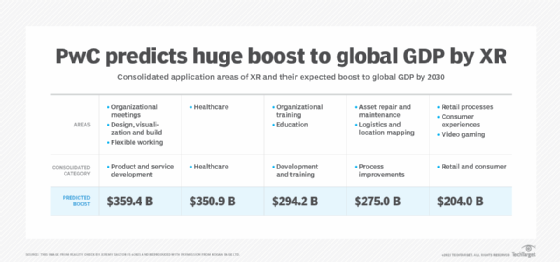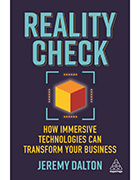New book explores business benefits of immersive technology
Immersive technologies will transform business, with weighty consequences for the global economy. Learn what extended reality can do in this book excerpt by PwC's XR chief.
In Reality Check: How Immersive Technologies Can Transform Your Business, expert author Jeremy Dalton, who leads PwC's extended reality (XR) team, explores the world of XR, an umbrella term that covers virtual reality, augmented reality, mixed reality, spatial and other assorted -- or still emerging -- categories of immersive technology. This book is for people with some familiarity with XR who are interested in its business applications, how XR is already being used, the main challenges of the tech and common myths associated with it. If you're "virtually curious," read this excerpt from the chapter titled "Why XR means business."
The value of XR in business stems from the unique attributes of each technology.
Strengths of virtual reality
Virtual reality's power comes from its ability to immerse users in an environment or perspective safely, cost-effectively and in less time than would be possible physically. This is the principal feature of VR that differentiates it from other technologies. It achieves this by:
- creating an emotional connection.
Successfully immersed users react to the virtual world in the same way that they would to similar circumstances in the real world. Place a user on a stage in an auditorium in front of a virtual audience of 1,000 people and they may feel anxious. Put a user on the receiving end of a verbally abusive rant and they might feel upset. Suspend them 100 meters above the ground to perform maintenance on a cell tower and it could cause them to panic. In other words, VR is capable of evoking a true-to-life sense of pressure, anxiety, awkwardness, empathy and a range of other emotions relevant to different workplace situations.
- providing a distraction-free environment.
How many times have you witnessed a colleague multitasking in a meeting, attempting to pay attention while transfixed by their mobile phone? Have you ever been on a video call, muted your microphone and minimized the window to work on other tasks? The modern world is full of tempting distractions across a range of devices. When you are engrossed in a completely virtual environment both visually and audibly, there are no application windows to open or close and it is much harder to quickly check a notification on your mobile phone without deliberately disconnecting from the experience and jumping between the virtual and the physical environment -- possible, but a process that carries more work, which acts as a natural disincentive.
- removing the constraints of the physical world.
While being an effective immersion tool, VR also doesn't limit you to what is physically possible. You can collaborate with colleagues in a virtual workshop without having to physically travel; spawn an unlimited number of screens without worrying about the logistics of transporting, setting up and powering them; and walk through a refurbished version of an office without having to buy any materials. 3D models can be resized to better examine them at a human scale: Molecular structures can be enlarged while towering buildings can be downscaled. VR also makes it possible to revisit a past scenario or simulate a future one in an impactful way. What would you do as the pilot of US Airways Flight 1549 after its engines had lost power? How could you simulate a scientific research mission on Mars?

Strengths of augmented reality
Augmented reality's power comes from its ability to connect to, make sense of and display information on the physical objects and environments around us in a user-friendly way. To expand on this, AR technology:
- communicates relevant information conveniently.
This information is displayed intuitively in context with the physical environment and objects. At a glance, a technician can view the current temperature and tempo of a machine they're looking at, receive instructions on how to safely take it apart and be visually guided to the next machine in the maintenance queue; a retailer can give customers the ability to view products remotely without any specialist hardware; a field worker can call for assistance remotely and within seconds a senior colleague on the other side of the world can see everything they're seeing and highlight which compartments to open, buttons to press and screws to remove.
- reveals the invisible.
Not everything can be seen with the naked eye -- from the network of pipes under our cities to the highways of veins beneath our skin, we live in a world of hidden machinery, and AR can help bring this information to the surface.
- performs hands-free.
Having both hands available is a requirement in many scenarios, from performing surgical procedures on patients to mechanical procedures on machinery. The key benefits are being able to save time, reduce risk and eliminate errors that come from having to refer to documentation or instructions that are away from your place of work or are inconvenient to access. You may be a mechanic examining the undercarriage of a vehicle. Having to stop, take out your smartphone or printed materials, refer to a complex set of instructions, commit them to memory, return to the task and successfully apply the information is a series of steps that is time-consuming, prone to error and potentially dangerous if you are working in a hazardous environment. In some cases, it may not even be possible -- if you are working in half a meter of mud servicing a broken-down tractor, it isn't practical to get out a tablet. And even where not absolutely necessary, implementing hands-free AR technology can lead to improved productivity.








